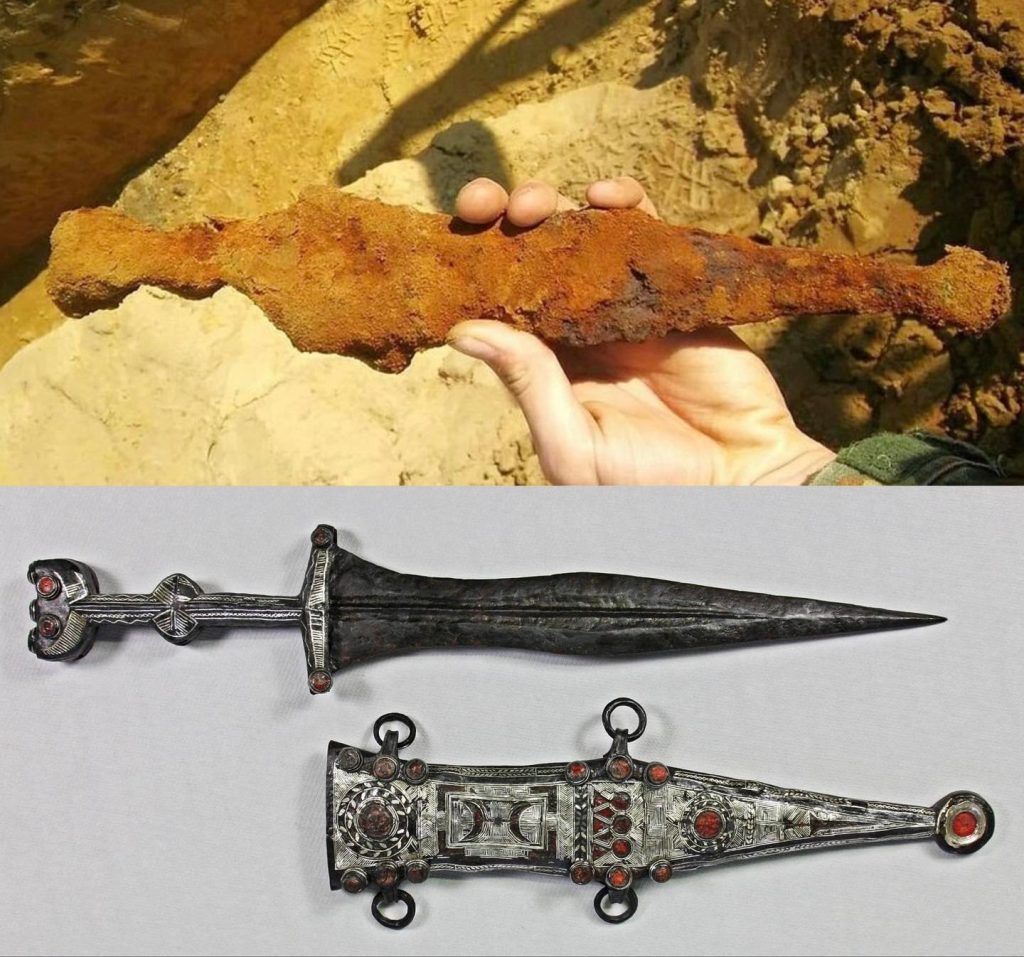After nine months of painstaking restoration, a silver dagger from ancient Rome and its sheath now shine as if newly crafted, their intricate decorations fully restored to their former glory. For Nico Calman, a 19-year-old intern with the Westphalie Department for the Preservation and Care of Field Monuments in Germany, this remarkable discovery marked an extraordinary milestone in his budding archaeological career.

Last year, while working at the archaeological site of Haltern am See in Germany, Calman unearthed a 2,000-year-old silver dagger buried in the grave of a Roman soldier. The weapon, which dates back to the first century A.D., might have played a role in Rome’s military campaigns against Germanic tribes during a tumultuous period of ancient history. Though its condition was severely deteriorated due to centuries of corrosion, the dagger’s restoration revealed it to be a stunningly adorned artifact of Roman craftsmanship.
When the dagger was discovered, it was still encased in its sheath and buried within an earthen block. The soldier’s grave was part of a larger cemetery near the ancient Roman military base at Haltern, a site that once stood on the fringes of the vast Roman Empire. During the Augustan period, which spanned from 37 B.C. to 14 A.D., Haltern served as a key military outpost. However, it also witnessed one of Rome’s most devastating defeats—the slaughter of up to 20,000 Roman soldiers by Germanic tribes in 9 A.D. The cemetery has been the focus of extensive archaeological work, yielding numerous artifacts over time.
Calman’s discovery of the dagger was a stroke of luck and skill. The weapon, embedded in rust, was almost unrecognizable when it was first unearthed. Recognizing the artifact’s potential significance, archaeologist Bettina Tremmel immediately sought the expertise of restorers. What followed was a meticulous process of sandblasting and preservation that transformed the relic into a spectacular piece of history.
The restored dagger measures 13 inches in length and features a grooved, tapered iron blade. Its handle and scabbard are inlaid with silver and glass, while the sheath—still adorned with remnants of red enamel—retains four rings that once attached it to the soldier’s leather belt. The sheath’s wooden lining also survived the centuries, adding another layer of detail to this extraordinary find. According to Tremmel, the dagger’s exquisite design indicates that it belonged to someone of significant status within the Roman military hierarchy.
Despite its ornate appearance, the dagger’s petite size suggests that it was more of a backup weapon than a primary tool of warfare. Likely reserved for close-quarters combat or emergencies, it would have been deployed only if the soldier’s sword was lost or damaged. Nevertheless, the craftsmanship of the blade and its accessories underscores the importance of personal weapons as symbols of identity and prestige in Roman culture.
For the team of archaeologists, the discovery was deeply moving. “We were lost for words,” Tremmel told Live Science. “Though thousands of Roman soldiers were stationed in Haltern over almost 15 years or more, there are only a few finds of weapons, especially complete and intact ones.” The combination of a fully preserved blade, sheath, and belt, along with detailed records of the artifact’s location within the grave, makes this find unparalleled in Roman archaeology.
The rarity of the discovery raises intriguing questions about why the dagger was buried with its owner. As Tremmel explained, it was not customary for Roman soldiers to be interred with their military equipment. Researchers continue to investigate the circumstances surrounding this unique burial, hoping to glean insights into the soldier’s life and the cultural practices of the time.
Dating back to the Augustan period, the dagger may have witnessed some of the most dramatic events in early Roman history. During this era, Haltern served as a strategic military base on the edge of Roman territory. The nearby Teutoburg Forest was the site of a catastrophic defeat for the Roman Empire in 9 A.D., when Germanic tribes ambushed and decimated three Roman legions. This loss forced the empire to abandon its ambitions of expanding further into Germania and remains a pivotal moment in Roman history.
The dagger’s journey from the battlefield to its burial and eventual discovery adds a poignant layer to its story. The soldier who once wielded it may have been among those who perished in the conflict or succumbed to other hardships of military life. The weapon’s preservation through centuries of burial and corrosion, followed by its restoration to near-original condition, is a testament to the enduring legacy of Roman craftsmanship and the meticulous work of modern archaeologists.
In 2022, the dagger will go on display at Haltern’s Roman history museum, allowing visitors to marvel at its intricate beauty and learn about its historical significance. As Michael Rind, director of archaeology at the Westphalia-Lippe council, explained to The Times, “This combination of a completely preserved blade, sheath and belt, together with the important information about precisely where they were found, is without parallel.”
For Calman, the experience of uncovering such a remarkable artifact has undoubtedly left a lasting impression. As an aspiring archaeologist, his discovery not only contributes to our understanding of Roman history but also serves as a reminder of the profound connections between past and present. The silver dagger, once a tool of war, now stands as a symbol of the artistry, resilience, and humanity of the ancient world.





